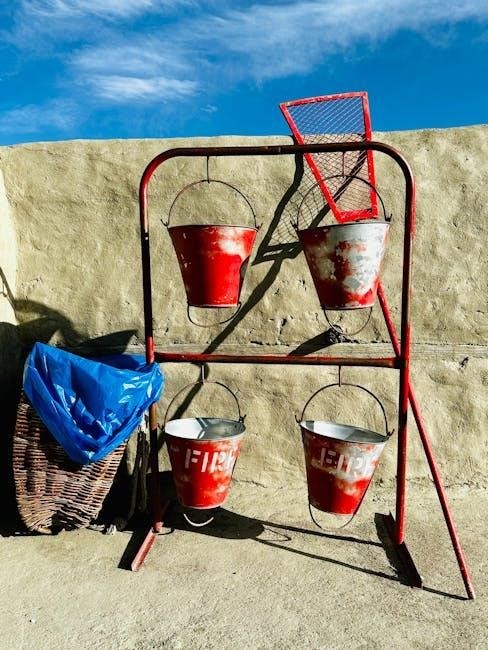
A UL 2-Hour Fire-Rated Wall Assembly is designed to withstand fire exposure for 120 minutes, ensuring structural integrity and safety. These assemblies, certified by Underwriters Laboratories, are crucial in commercial and residential buildings to meet fire safety codes and protect occupants.

Understanding UL Certification for Fire-Rated Assemblies
UL (Underwriters Laboratories) certification for fire-rated assemblies is a critical benchmark for ensuring that building components meet rigorous fire safety standards. UL certification involves extensive testing of wall assemblies to determine their ability to withstand fire exposure while maintaining structural integrity and preventing the spread of flames and smoke. These tests are conducted in accordance with standards such as ASTM E119/UL 263, which evaluate the assembly’s fire resistance rating in hours. A 2-hour fire rating indicates that the assembly can endure fire for 120 minutes without failing, providing sufficient time for evacuation and firefighting efforts.
The certification process involves evaluating the entire assembly, including all components such as gypsum board, insulation, and framing systems. UL Design Numbers, such as U301 or V497, are assigned to approved assemblies, specifying the exact materials and configurations that meet the required fire resistance criteria. Architects, contractors, and code officials rely on UL certification to ensure compliance with building codes and to guarantee that fire-rated assemblies perform as intended in real-world fire scenarios. This certification is essential for maintaining public safety and adhering to regulatory requirements in both residential and commercial construction projects.

Key Components of a 2-Hour Fire-Rated Wall Assembly
A 2-hour fire-rated wall assembly consists of carefully selected materials that work together to provide structural integrity and fire resistance for 120 minutes. The primary components include fire-resistant gypsum board, insulation materials, and a robust framing system. Gypsum board, typically Type X, is a critical element due to its high fire-resistance properties. It is often installed in multiple layers, with the inner layer providing additional thermal protection.
Insulation materials, such as mineral wool or fiberglass, are incorporated to fill cavities and prevent heat transfer. These materials are non-combustible and help maintain the assembly’s integrity during exposure to high temperatures. The framing system, which can be wood or steel studs, must be rated for fire resistance and is designed to support the weight of the wall while withstanding fire conditions.
Other essential components include sealants and fire-stopping materials, which prevent the spread of flames and smoke through gaps or penetrations. The combination of these elements, when installed correctly, ensures the assembly meets UL standards and provides reliable fire protection in commercial and residential buildings. Each component plays a vital role in achieving the required 2-hour fire rating, ensuring safety and compliance with building codes.

Common UL Designs for 2-Hour Fire-Rated Walls
UL-certified 2-hour fire-rated wall assemblies are designed to meet specific fire safety requirements in commercial and residential construction. One of the most common designs involves the use of two layers of Type X gypsum board on one side of the wall, combined with mineral wool insulation in the cavity. This configuration ensures both thermal and structural integrity during a fire.
Another widely used design incorporates a single layer of Type X gypsum board on the exterior, paired with a layer of fire-resistant insulation. This assembly is often specified for exterior walls, where fire exposure is a primary concern. Additionally, designs like UL U301 and U348 are popular for their adaptability to load-bearing and curtain wall systems, respectively.
These designs typically include steel studs or wood framing, which must be rated for fire resistance. The use of sealants and fire-stopping materials is also critical to prevent flame and smoke penetration at joints and penetrations. By following these proven configurations, architects and contractors can ensure compliance with building codes and provide reliable fire protection in various applications.
Importance of 2-Hour Fire-Rated Wall Assemblies in Building Codes
2-Hour Fire-Rated Wall Assemblies play a critical role in building codes by ensuring the structural integrity and safety of occupants during fires. These assemblies are mandated in high-rise buildings, hospitals, and other occupancies where fire containment is paramount. By providing a 120-minute fire barrier, they allow sufficient time for evacuation and emergency response, reducing the risk of loss of life and property damage.
Building codes, such as the International Building Code (IBC), require fire-rated walls to separate different occupancies and prevent the spread of fire between compartments. These requirements are enforced to maintain public safety and ensure that buildings can withstand fires long enough for emergency services to respond effectively. Compliance with these codes is verified through UL certification, which guarantees that the assemblies meet rigorous testing standards. This ensures consistency and reliability in fire protection across various construction projects, safeguarding both the occupants and the structure itself.
Materials and Their Role in Achieving a 2-Hour Rating
The achievement of a 2-hour fire rating in wall assemblies relies heavily on the selection of appropriate materials. Fire-resistant gypsum boards, often designated as Type X, are a cornerstone of these systems due to their ability to withstand high temperatures for extended periods. When installed correctly, these boards provide a thermal barrier that slows the spread of fire and heat transfer.
In addition to gypsum boards, materials such as fire-resistant insulation play a crucial role. Insulation helps to fill gaps between structural components, preventing the penetration of flames and hot gases. Fire-resistant caulks and sealants are also essential, as they maintain the integrity of the assembly by sealing any joints or openings that could compromise the fire barrier.
Structural components like steel studs or wood framing must also meet specific criteria to contribute effectively to the fire rating. The combination of these materials, when properly assembled and tested, ensures that the wall can endure a 2-hour fire exposure without failing. Each material’s properties and interactions are carefully considered to meet UL certification standards, ensuring reliable performance in real-world fire scenarios.
Design Considerations for Fire-Rated Wall Assemblies
Designing a 2-hour fire-rated wall assembly requires careful consideration of structural integrity, thermal performance, and fire containment. Load-bearing walls must support structural loads while maintaining fire resistance, whereas non-load-bearing walls focus primarily on fire and smoke barriers. The selection of materials and their arrangement are critical to ensure the assembly meets UL standards and building codes.
One key consideration is the inclusion of firestops, which prevent the spread of fire through penetrations in the wall. Properly sealing gaps around electrical outlets, pipes, and other openings is essential to maintain the integrity of the fire-rated assembly. Additionally, the use of insulation within wall cavities can enhance fire resistance by reducing heat transfer and delaying the collapse of structural elements.
Designers must also balance aesthetic and functional requirements, such as incorporating fire-resistant glass for visibility while maintaining the 2-hour rating. The configuration of studs, panels, and fasteners must align with tested UL designs to ensure compliance. By addressing these factors, architects and contractors can create safe, durable, and code-compliant fire-rated wall assemblies.
Testing and Certification Process for Fire-Rated Assemblies
The testing and certification process for fire-rated assemblies involves rigorous evaluation to ensure compliance with fire safety standards. Assemblies are subjected to standardized fire tests, such as ASTM E119 or UL 263, which measure their ability to withstand fire exposure while maintaining structural integrity and limiting heat transfer.
During testing, the assembly is exposed to a controlled fire in a furnace, simulating real-world fire conditions. The performance is evaluated based on three criteria: structural integrity, insulation, and the ability to prevent flame penetration. The assembly must maintain its load-bearing capacity and resist the passage of heat and flames for the specified rating period, such as 2 hours.
Once an assembly passes the tests, it is certified by organizations like Underwriters Laboratories (UL). Certification includes detailed documentation, such as design drawings, material specifications, and test results. This documentation ensures that the assembly can be replicated in the field to meet fire safety requirements. Regular inspections and maintenance are also required to uphold the certification and ensure ongoing compliance with building codes.
This process ensures that fire-rated assemblies provide reliable protection in the event of a fire, safeguarding lives and property. By adhering to these strict testing and certification protocols, architects and contractors can trust the performance of these critical building components.
Fire-Resistant Glass and Framing Systems
Fire-resistant glass and framing systems are essential components in achieving 2-hour fire-rated wall assemblies. These systems are designed to maintain integrity and prevent the spread of fire and smoke, even when exposed to high temperatures. Fire-resistant glass, such as ceramic glass, is engineered to withstand thermal stress and remain intact during a fire, providing a barrier against flames and heat transfer.
Framing systems, often constructed from steel or specialized fire-resistant materials, are tested to ensure compatibility with fire-resistant glass. Together, these components form a comprehensive fire barrier that meets stringent standards like ASTM E-119 and UL 263. Advanced systems, such as the GPX FireFloor System, combine fire-resistive glass with framing to achieve up to 2 hours of fire resistance, making them ideal for applications requiring transparency and safety.
These systems are widely used in curtain walls, stairwells, and other areas where visibility is crucial. Proper installation and certification are critical to ensure performance, as outlined in UL fire-resistance directories. Fire-resistant glass and framing systems play a vital role in modern construction, balancing aesthetics with fire safety requirements.

Installation Best Practices for Fire-Rated Assemblies
Proper installation of fire-rated assemblies is critical to ensure their performance in a fire event. Adhering to UL-tested designs and manufacturers’ instructions is essential to maintain the integrity of the system. All components, including gypsum boards, insulation, and fasteners, must be installed as specified in the certified design to achieve the required 2-hour rating.
Sealing penetrations and joints with approved materials is vital to prevent fire and smoke leakage. Fire-rated assemblies must be continuous, with no gaps or voids that could compromise their effectiveness. Regular inspections during and after installation ensure compliance with UL standards and building codes.
Only UL-certified materials should be used, as substitutions can void the certification. Additionally, installers should follow proper sequencing to avoid damage to components during construction. Training and experience in fire-rated assembly installation are recommended to ensure adherence to best practices and safety protocols.
Documentation and verification of the installation process are also important to demonstrate compliance with regulatory requirements. By following these best practices, fire-rated assemblies can provide reliable protection, safeguarding lives and property in the event of a fire.

Applications in Load-Bearing and Curtain Wall Systems
UL 2-hour fire-rated wall assemblies are widely used in both load-bearing and curtain wall systems to provide structural support and fire protection. In load-bearing applications, these assemblies are designed to support the building’s weight while maintaining fire resistance, making them ideal for multifamily and commercial construction.
In curtain wall systems, fire-rated assemblies are often integrated to protect exterior walls and maintain the integrity of the building envelope. This is particularly important for high-rise buildings, where fire containment is critical. UL-rated systems ensure that both structural stability and fire performance are maintained, even under extreme conditions.
These assemblies are commonly specified in projects where fire safety is paramount, such as in schools, hospitals, and high-occupancy buildings. Their versatility allows them to be used in various configurations, from exterior walls to interior partitions, ensuring comprehensive fire protection throughout the structure.
By combining load-bearing capabilities with advanced fire resistance, UL 2-hour fire-rated wall assemblies play a crucial role in modern building design, ensuring both safety and structural integrity.
Documentation and Resources for Architects and Contractors
Architects and contractors can access comprehensive documentation for UL 2-hour fire-rated wall assemblies through various resources. The UL fire resistance directories provide detailed listings of certified assemblies, including specific designs like U301 and U348, which are commonly used in load-bearing and curtain wall systems.
manufacturers like LP FlameBlock and Thermafiber offer product specifications, assembly drawings, and installation guidelines for their fire-rated materials. These resources ensure compliance with ASTM E119 and UL 263 standards, critical for achieving the required fire ratings.
Additional tools include technical bulletins, such as those from GPX FireFloor, which detail fire-resistant glass and framing systems. These documents are essential for designing fire-rated assemblies in high-rise buildings and other critical applications.
For planning and estimation, wall assembly files and design guidelines are available online, covering various UL wall types. These resources help architects and contractors streamline the specification and installation processes, ensuring both safety and code compliance.
By leveraging these resources, professionals can confidently design and construct fire-rated wall systems that meet stringent building codes and provide reliable fire protection.